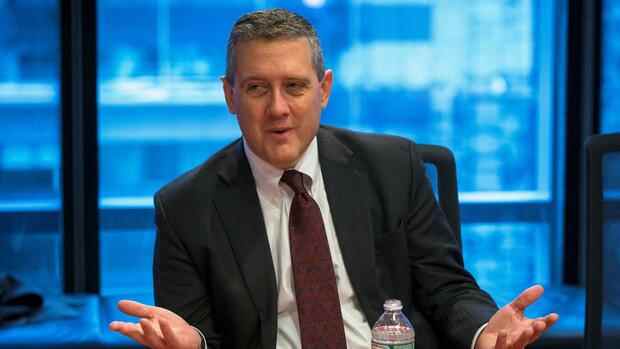The next Fed meeting is on May 3rd and 4th. The central bank may raise the key interest rate by half a percentage point.
(Photo: Reuters)
Dusseldorf In view of the strong price pressure in the US, more and more economists are in favor of a clear reaction from the Fed at its next meeting. James Bullard, head of the St. Louis regional Fed, reiterated his call for a more aggressive fight against high inflation on Tuesday.
The idea that a modest rate hike could dampen price pressures is “fantasy,” Bullard said in an interview with the Financial Times. Rather, an interest rate level is necessary that restricts the economy.
In March, consumer prices in the US rose by 8.5 percent compared to the same month last year. This is the biggest plus since 1981. The price level increased across the board. Energy and food, among other things, became significantly more expensive. The core inflation rate, which excludes these volatile prices, was 6.4 percent.
The latest data reinforces the need for the Fed to act urgently and raise rates, Bullard said. The central bank must combat the components of inflation that are stubbornly driving prices. It is therefore necessary to raise interest rates more than in the “neutral zone” – i.e. to a level at which interest rates neither drive nor slow down the economy.
Top jobs of the day
Find the best jobs now and
be notified by email.
The head of the St. Louis Fed is currently regarded as one of the biggest “hawks”, ie as a supporter of tight monetary policy. Most recently, he explained that the Fed would have to raise interest rates to 3.5 percent even in an optimistic scenario. Bullard is one of the five regional presidents currently sitting on the Fed’s Open Market Committee (FOMC), which makes key monetary policy decisions.
The next Fed meeting is on May 3rd and 4th. The central bank will present new forecasts for interest rate and labor market developments at its next but one meeting in June. Experts believe it is quite possible that the Fed will raise interest rates by half a percentage point at each of the next two meetings. At least that’s according to a survey of economists by the Reuters news agency. At its last meeting in March, the Fed turned around and raised interest rates to a level of 0.25 to 0.50 percent. Such a step of a quarter of a percentage point is considered normal.
Thomas Barkin, head of the Richmond regional Fed, was more cautious. First of all, he calls for interest rates to be raised quickly into neutral territory. According to current Fed data, this should be just over two percent. Once that level is reached, the Fed should “Testing whether the inflationary pressures of the pandemic era are abating and how persistent inflation has become,” Barkin told a New York University event. “If necessary, we can go further.”
At an online summit of the Wall Street Journal, Fed Director Lael Brainard emphasized that the central bank could ease price pressure without having a lasting impact on the economy and the labor market. She also declared that she wanted to reach the neutral interest rate level “quickly”.
Parallel to an increase in interest rates, the Fed balance sheet, which has recently swelled to almost nine trillion dollars, should also be reduced. This would mean that the central bank would no longer replace all of the maturing bonds in its portfolio.
What is particularly interesting here is the rate of degradation. A decision on this could be made at the May meeting, Brainard said, so that the balance sheet reduction could begin in June.
More: Inflation rate in the US climbs to 8.5 percent – the highest level in over 40 years


